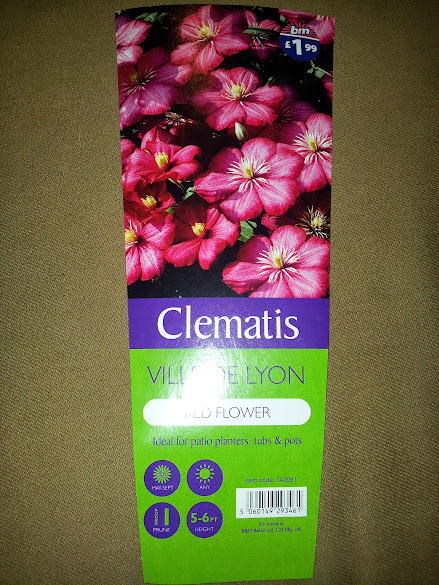Saturday 12 April 2014
Ville Du Lyon
Dont Always Trust The label
As I have previously mentioned Clematis come in 3 Group's. I wanted to get a new Clematis so I picked up this Ville De Lyon. On the front of the packet it states that this Clematis is Group 1 However it's actually a group 3 plant. meaning instead of pruning at the end of flowering you prune early on in the season around February cutting the plant to about a foot from the ground and it starts to grow back from fresh each year.
Further reading on the web Here and Here Show that this Clematis is a Herbaceous Variety that should be cut very low either in late autumn or early spring. The flowers appear on new growth. The flowers start off early in the season (fairly large rather like my champaign Clematis) and get smaller through out the season.
As the plant grows the lower part tends to go brown and woody and loose all its foliage so its a good idea to grow the lower part hidden by or through a rose as a companion plant. I have added a picture to show the flowers type. This is not in my garden. This is another good article worth a read
Ville De Lyon has Red to Purple flowers with a pink bar, a profusion of flowers which last most of the summer. So for me I am looking forward to having something that flowers latter in the season than my other two Clematis
Labels:
Champagne,
Clematis,
miltonkeynesgarden,
Ville Du Lyon
Location:
Milton Keynes, UK
Tuesday 1 April 2014
Summer planting
Summer Planting
 I would like to get some more colour into the Garden this summer so I have decided to add some large flowering plants that I can also use as cut flowers for the house.
I would like to get some more colour into the Garden this summer so I have decided to add some large flowering plants that I can also use as cut flowers for the house.
Dahlias are tender plants in the daisy family, Asteraceae, and are native to Mexico. Their flowers range widely in size, color, shape, and number of petals, making dahlias among the most diverse flowers, with thousands of varieties.
Dahlias are heavy feeders and require plenty of water and fertilizer. Feed weekly with a liquid fertilizer until flower buds appear and be sure to keep soil moist. Dahlias are sensitive to drought and may not bloom if they are allowed to dry out. Mulch around the plants to retain moisture. Remove spent flowers to encourage continued blooming.
As Dahlias need a lot of feeding I have some Manure that I am going to dig into the Beds Now in preparation for the planting in about a months time. I need to get some stakes to put in the ground as well for tying the dahlias to.
Siberian Iris (Blue King)
'Blue King' _ 'Blue King' is a clump-forming, herbaceous perennial with linear, strap-like, grey-green leaves and erect stems bearing deep purple-blue flowers with yellow markings in late spring and early summer.Grow in most soil that is preferably moist but not waterlogged. In drier soils, dig in well-rotted manure before planting and apply as a mulch each spring.
Iris sibirica 'Blue King' (Siberian iris 'Blue King') will reach a height of 0.9m and a spread of 0.4m after 2-5 years.
To aid establishment, water Siberian irises once a week during hot, dry weather. Water when needed for at least one full growing season.
Plants seldom bloom the first year after planting. Siberian irises should be blooming well by the third or fourth year. They will eventually form large, well-established clumps.
Hemerocallis
Daylily is the common name for plants of the genus Hemerocallis /ˌhɛmɨroʊˈkælɪs/.[1]Daylily cultivar flowers are highly diverse in colour and form, as a result of hybridization efforts of gardening enthusiasts and professional horticulturalists. Thousands of registered cultivars are appreciated and studied by local and international Hemerocallis societies.[2] Hemerocallisis now placed in family Xanthorrhoeaceae, subfamily Hemerocallidoideae, and formerly was part of Liliaceae (which includes true lilies).
Mulching plants with shredded leaves or other light organic matter goes a long way toward ensuring moisture retention.
I am really looking forward to seeing how these plants turn out. So later in the season I will post some pictuers to show you how they did.
Subscribe to:
Posts (Atom)






